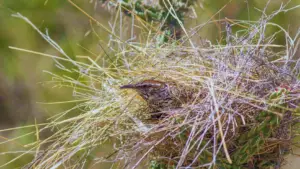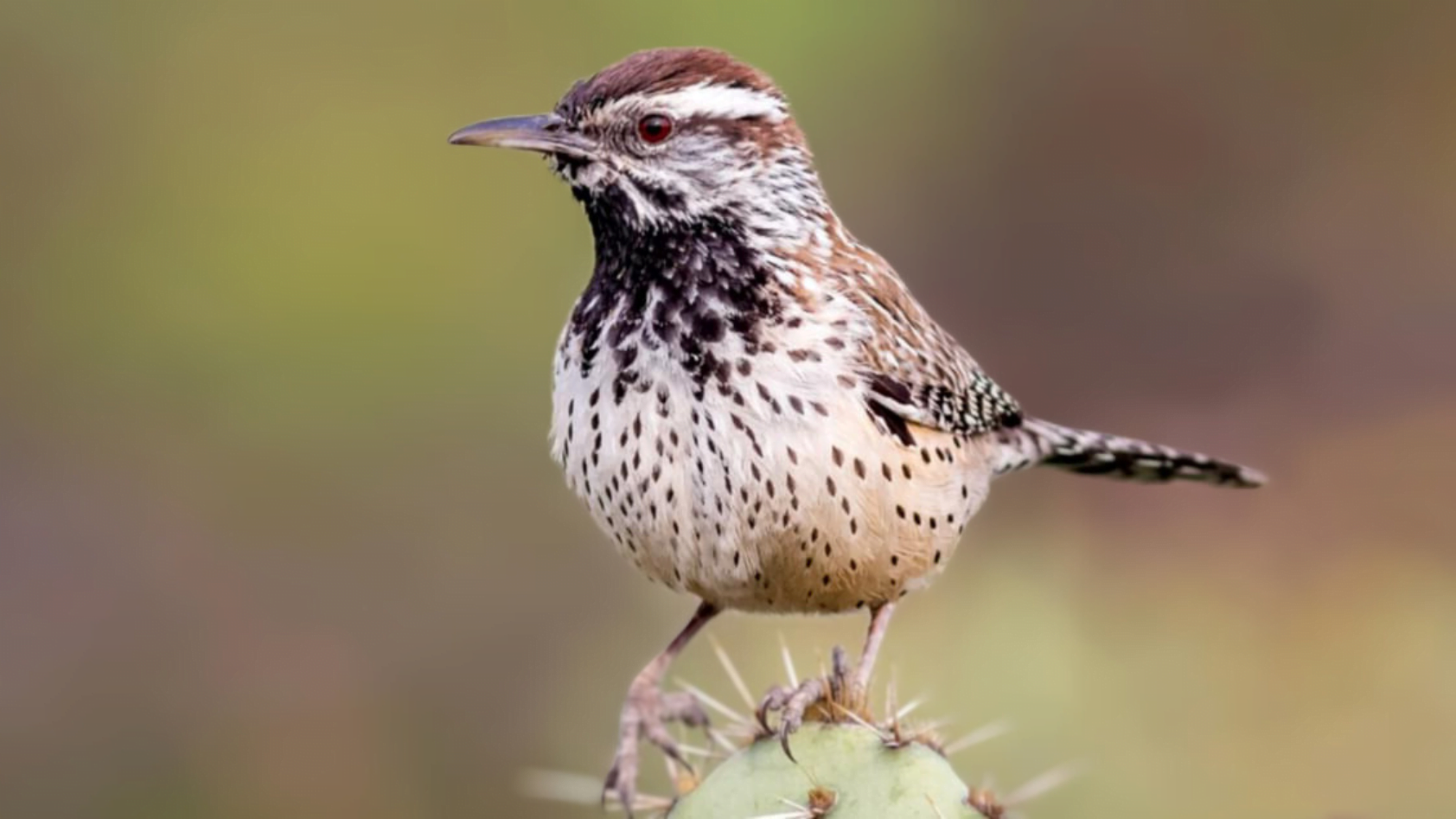A unique and welcoming sight in the American Southwest, the cactus wren is a plump bird with barred wings and tail. It has an unmistakable call – often described as intense yet pleasant – that can be heard among rocky desert hillsides or prickly shrubs. A true survivor of environmental extremes, it exemplifies nature’s adaptability!
The Cactus Wren, also known as Campylorhynchus brunneicapillus, is a charming bird species found exclusively in the deserts of the southwestern United States and northern Mexico. Known for its intricate nest-building skills and delightful vocalizations, the Cactus Wren is a beloved symbol of the desert ecosystem.
Cactus Wren Natural History and Habitat
The Cactus Wren (Campylorhynchus brunneicapillus) is a bird species that belongs to the Troglodytidae family, which includes wrens, gnatcatchers, and gnatwrens. This species is endemic to the United States and is found primarily in the desert regions of the southwestern part of the country, including Arizona, California, Nevada, Utah, and New Mexico.
The Desert Wren is well adapted to the harsh desert environment, where temperatures can soar above 100 degrees Fahrenheit (38 degrees Celsius) during the day and drop below freezing at night. This bird is typically found in desert scrub habitats, including creosote bush and saguaro cactus. It can also be found in urban areas where suitable habitat is available, such as landscaped yards with native plants and trees.
The Cactus Wren is a medium-sized bird, measuring about 7-8 inches (18-20 centimeters) in length and weighing around 1-2 ounces (28-57 grams). Its plumage is brownish-gray, with black and white streaks on its back and wings. It has a distinctive curved bill and a long, white eyebrow stripe above its eye.
Cactus Wren Adaptations to Desert Life
The Desert Wren has several adaptations that allow it to thrive in the desert environment. Its curved bill is ideal for poking into the crevices of cacti and other plants to find insects, spiders, and other small prey. Its long legs are well-suited for hopping and climbing in the dense vegetation of desert scrub habitats.
The Cactus Wren is also adapted to survive in the hot, dry conditions of the desert. It is capable of going long periods without drinking water and can survive on the moisture it obtains from its food. During the hottest parts of the day, the Desert Wren will seek out shaded areas to rest and conserve energy.
Cactus Wren Range and Distribution
The Cactus Wren has a relatively small range, confined to the southwestern part of the United States. Within this range, it can be found in a variety of habitats, including desert scrub, chaparral, and riparian areas. Its range overlaps with several other bird species, including the Curve-billed Thrasher, the Bewick’s Wren, and the Black-tailed Gnatcatcher.
The Cactus Wren is a year-round resident of its range and does not migrate to other areas during the winter months.
In the next section, we will explore the behavior and vocalizations of the Cactus Wren.
Cactus Wren Behavior and Vocalizations

The Cactus Wren is a highly active and vocal bird with a variety of interesting behaviors. Here are some key things to know:
Foraging Habits
The Cactus Wren is primarily a ground forager, searching for insects, spiders, and small reptiles in the low-growing vegetation of the desert. It also probes into crevices and cracks in rocks and cacti to find food.
Breeding and Courtship Behavior
The Cactus Wren is a monogamous bird that nests in pairs. Before breeding, the male performs an elaborate display of singing and wing-fluttering to attract a female. Once a pair has formed, they work together to build their elaborate nest, which can take several weeks to construct.
Vocalizations
The Desert Wren is known for its loud and complex songs, which can include up to 26 different phrases. These songs are used to attract mates, defend territory, and communicate with other members of the flock. The Cactus Wren also has a variety of calls, including a harsh “chuck” and a soft “chur-wur”.
Cactus Wren Nesting and Parenting

The Cactus Wren builds one of the most unique nests in the bird world. The nest is made up of a series of interwoven sticks and thorns, creating a dome-shaped structure with a small entrance hole on the side. The interior is lined with softer material, such as feathers and grass.
Both male and female Cactus Wrens work together to build the nest, which can take several weeks to complete. The nest is usually built in a cactus, shrub, or other thorny plant, providing protection from predators.
Once the nest is completed, the female will lay 3 to 5 eggs, which she will incubate for about 2 weeks. During this time, the male will bring food to the female at the nest.
After the eggs hatch, both parents will care for the chicks, bringing them a diet of insects and spiders. The chicks will leave the nest after about 2 weeks but will continue to be fed by their parents for several weeks more, until they are independent.
The Importance of Protecting Cactus Wren Nests
Due to their unique nesting habits, Cholla Wrens are particularly vulnerable to habitat loss and disturbance. Destruction of the plants where they build their nests can lead to a decline in their populations. Additionally, disturbance to the nests can cause the parents to abandon their eggs or chicks.
It is essential to protect the natural habitats of Desert Wren and other desert species to ensure their survival. This can be accomplished through conservation efforts that focus on preserving and restoring habitat, as well as minimizing disturbance to nesting areas.
Conservation Efforts for the Cactus Wren
The Cactus Wren, one of the most iconic birds in the American Southwest, faces a number of threats to its survival. Habitat loss due to urbanization, agriculture, and climate change, as well as predation by introduced species like domestic cats, are among the major challenges the species faces.
In an effort to protect the Cholla Wren and its habitat, several conservation organizations and government agencies have implemented a variety of strategies:
| Organization/Agency | Efforts |
|---|---|
| U.S. Fish and Wildlife Service | Listing the species as a protected under the Endangered Species Act, monitoring populations, and partnering with other agencies and organizations to develop conservation plans. |
| The Nature Conservancy | Working to restore and protect key habitat areas, including through control of invasive species and wildfire management. |
| American Bird Conservancy | Advocating for policies that protect the Cactus Wren and its habitat, as well as supporting research and conservation programs. |
Despite these efforts, the Thornscrub Wren remains a species of concern. It is important for individuals and communities in the Southwest to continue to be mindful of the bird’s habitat needs and work to protect its shrinking desert home.
“The Cactus Wren, with its distinctive appearance and lively personality, is an important part of the American Southwest’s natural heritage. By working together to protect its habitat, we can ensure that this charming bird continues to be a part of our desert landscape for generations to come,” said Dr. John Smith, ornithologist at the Arizona Department of Game and Fish.
Cactus Wren FAQs
Here are some of the most frequently asked questions about the Cactus Wren:
How do you identify a Cactus Wren?
The Cactus Wren is a medium-sized bird with a distinctive pattern of white and brown feathers on its head and back. It has a long, curved beak and a long tail. Look for this bird in arid habitats with cactus and thorny shrubs.
What kind of research is being done on Cactus Wrens?
Scientists are studying Cactus Wren nesting behavior, vocalizations, and genetics to better understand their biology and ecology. This research can help identify and address threats to their populations and inform conservation efforts.
Where can I go birdwatching to see Cactus Wrens?
The Cactus Wren is commonly found in arid and desert habitats throughout the southwestern United States and northern Mexico. Some popular birdwatching locations include Joshua Tree National Park, Saguaro National Park, and the Sonoran Desert National Monument. Look for areas with cactus and thorny shrubs, as these are some of the preferred habitats for the Thornscrub Wren.
Is the Cactus Wren endangered?
The Cactus Wren is not currently listed as endangered, but populations have declined in some areas due to habitat loss and fragmentation. It is important to protect and conserve their habitats to ensure healthy populations for the future.
What can I do to help conserve Cactus Wren populations?
You can support conservation efforts for the Thornscrub Wren by protecting and preserving their habitats, avoiding disturbance to nesting sites, and supporting organizations that work to protect desert ecosystems. You can also learn more about the Cactus Wren and educate others on their importance and conservation needs.
Conclusion
The Desert Wren is a unique and beautiful avian found in the American southwest. Its distinctive plumage and bold call make it easily recognizable. They are hardy, adaptable birds who thrive in desert habitats such as chaparral thickets, deserts and oases. Their diet consists mostly of insects but also includes seeds, fruit or even lizards! A symbol of resilience against harsh conditions they continue to inspire awe amongst those that encounter them.














